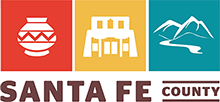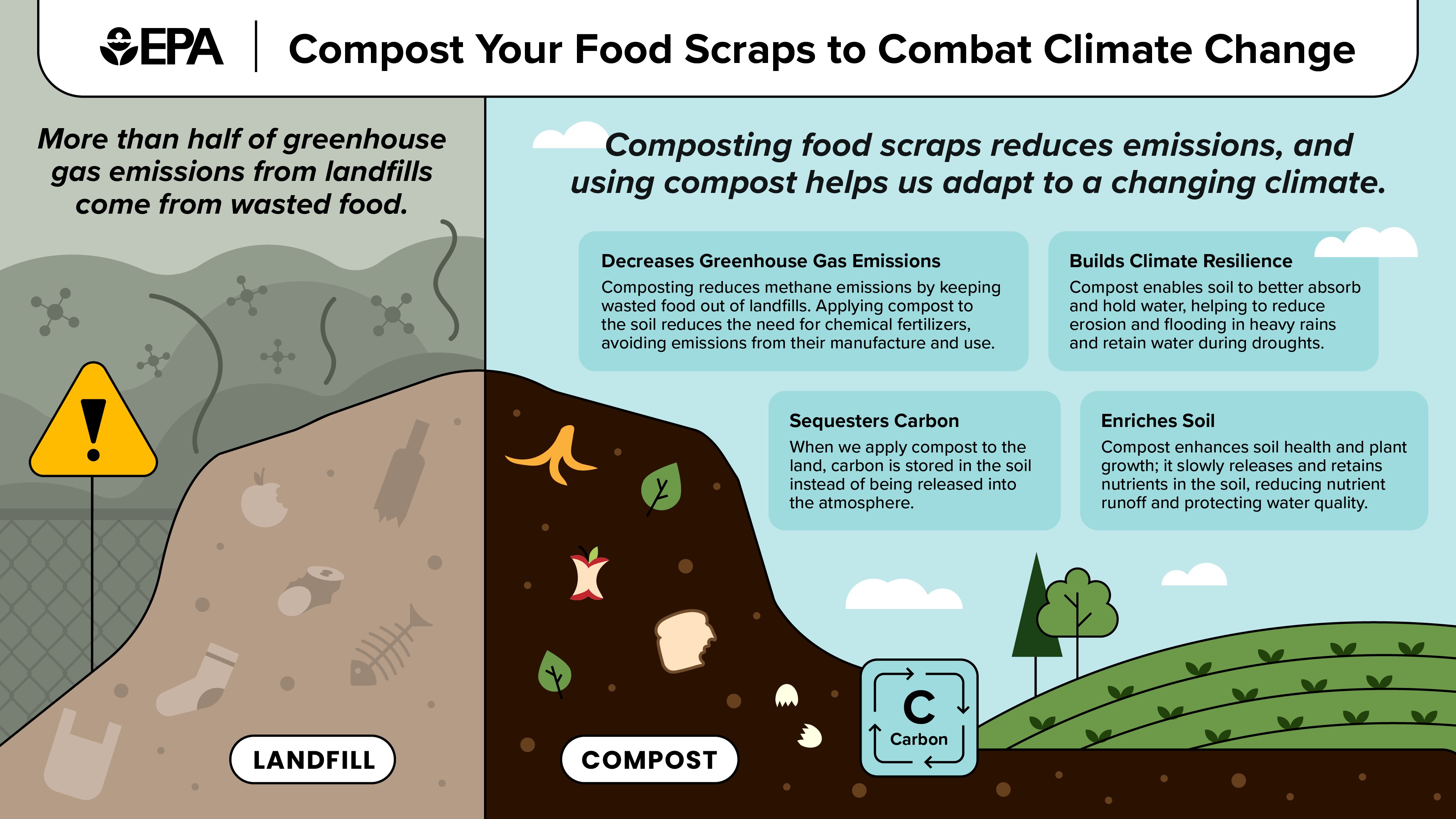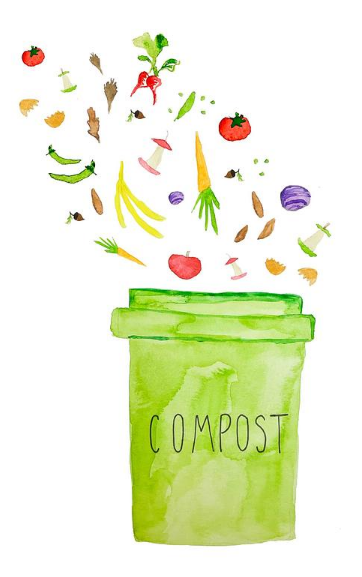![]()
Compost
Composting transforms organic materials, such as vegetable scraps, leaves, and other waste, into a rich soil amendment that can benefit your garden and the environment.

Backyard Composting Program - 2025 Season - APPLICATIONS CLOSED
Fall 2025 Update: The application window is currently closed, but you are welcome to join the waitlist by completing this online application. If you have any questions, please reach out to Elizabeth at ehoughton@santafecountynm.gov.
About the Program: This program offers free compost system installations and training on a first-come, first-served basis to residents who live in unincorporated areas of Santa Fe County. Roughly one-third of household waste consists of organic matter (like food and yard trimmings), and the goal of the residential compost program is to reduce the amount of organic waste sent to the landfill. Composting reduces greenhouse gas emissions, saves time and money by minimizing trips to transfer stations, and creates a soil amendment that helps plants flourish.
Compost Systems and Support: Santa Fe County residents who participate in the program will receive a free composting system. They can choose between a black plastic composting system and a strawbale composting system, and installation and instruction will be provided by a third-party community compost partner. Participants will also receive composting guidance and support, a small collection bin for kitchen scraps, a pitchfork to turn and manage the compost pile, and red wiggler composting worms at no cost.
Eligibility: The backyard composting program is available to residents living in unincorporated areas of Santa Fe County. This means that participants must reside inside Santa Fe County but outside Santa Fe city limits.
This program is generally intended for residents who do not currently compost their waste, but exceptions will be considered on a case-by-case basis. For instance, if a new composting system will help a resident divert more organics from the landfill than they can with their current system, that resident would be eligible to participate in the program.
Application Process: The application period is open for thirty days this year, from July 29 to August 27. Selected participants will be contacted by email in September to plan next steps, and the installations will take place from late September through early December 2025. This is a first-come, first-served program, so those who sign up early will have their applications prioritized. However, any additional sign-ups will be added to a waitlist.
Santa Fe County residents can apply for this program in one of three ways:
- Complete this online application.
- Complete a physical application in person at the County Admin Building, Public Works Building, Edgewood Senior Center, or Pojoaque Satellite Office. Applications are available at the reception desks at all these locations.
- Complete this PDF application and then email it, send it in the mail, or drop it off in person at one of the designated locations listed above.
More Information: If you have any questions, please contact Elizabeth Houghton, Santa Fe County Sustainability Specialist, at ehoughton@santafecountynm.gov or (505) 986-6392.
Expected Timeline for 2025 Program Participants:
- July 29, 2025: Applications open.
- August 27, 2025: Applications close.
- September 2025: All applicants will be notified whether they have been accepted into the 2025 backyard composting program or added to a waitlist.
- September - November 2025: Site assessments are conducted, educational materials are shared, and compost systems are installed.
- Participants will receive seasonal “composting tips” emails from fall 2025 through summer 2026, as well as a participation survey in fall 2026.
Why compost?
Food waste, yard waste, and other organic materials can be used to create compost, which builds soil health and enhances plant growth while decreasing greenhouse gas emissions.
Composting Benefits:
- Enhance Soil Health and Plant Growth: Compost enriches the soil with organic matter, providing essential nutrients that help plants grow. It also improves the soil structure, allowing it to absorb and hold water more easily. This supports plant health while helping to prevent flooding and erosion.
- Save Time and Money: When you compost organic waste (like food scraps), you send less material to the landfill. If you would normally take your waste to a convenience center, reducing waste through composting means fewer visits and less money spent on disposal fees.
- Reduce Emissions: Approximately 24% of the material in our landfills is food waste, but it creates more methane emissions than anything else there because of its rapid anaerobic decomposition. Methane is a greenhouse gas that is 28x more powerful than CO2, and food waste is responsible for 58% of methane emissions from landfills. This is a significant source of pollution, and greenhouse gas emissions from landfilled food waste in the US are equivalent to the annual emissions of 15 coal-fired power plants. When you compost organic waste instead of sending it to the landfill, you reduce these emissions while transforming your waste into a beneficial soil amendment.
- Sequester Carbon: When compost is used to amend the soil, it adds carbon to the soil instead of the atmosphere. Carbon is beneficial in the soil, where it supports plant growth, improves water retention, and reduces erosion. Sequestering carbon in the soil, rather than releasing it into the atmosphere, can also help mitigate climate change.
What Can I Compost?
Composting Ingredients
The composting process requires nitrogen, carbon, air, and water. Nitrogen is provided by fresh organic material like food scraps, coffee grounds, and grass clippings. These materials are commonly referred to as “greens”. Carbon is provided by dryer materials like dead leaves, branches, twigs, and paper, which are commonly referred to as “browns”. To achieve a good carbon-to-nitrogen ratio, a helpful rule of thumb is to have 2x to 4x as much brown material as green material. Layering materials and turning compost piles regularly speed up the composting process by creating optimal airflow, and it’s important to maintain an adequate moisture level here in the high desert.
If it grows, it goes!
Anything that was once alive or is derived from living matter can theoretically be composted. However, the type of compost system being used will impact what items can successfully break down. Home composting systems are great for things like fruit and vegetable scraps, coffee grounds and paper filters, leaves and yard waste, and paper towels. Large commercial composting systems can handle additional items like meat, bones, fish, dairy, and BPI-certified compostable products. While these items are biodegradable, they are generally not a good fit for home composting systems because they can smell, attract wildlife, and/or take a long time to break down.
When in doubt, throw it out.
Non-organic items like metal, glass, styrofoam, ceramics, plastic, or plastic-coated products cannot be composted. These include produce stickers, staples, rubber bands, and paper products that have a plastic coating (like coffee cups). While weeds with seeds and diseased plants do decompose, they are generally not composted because they can compromise the integrity of the final compost product as a soil amendment. One approach to successfully composting weeds with seeds is to place the weeds in a black plastic bag in the sun for a couple of days. The high temperature kills the seeds and keeps them from growing in the compost. In this particular area, it is also helpful to avoid adding wood ashes to home compost systems. The soil here is very alkaline, and this increases the alkalinity even further.
How can I start composting?
If you live in an unincorporated area within Santa Fe County, you may wish to apply for the county’s Backyard Composting Program. Participants receive a compost system and supplies, along with guidance and support, at no cost. You can learn more about the program at the top of this webpage. If this program is not a good fit, or the timing doesn’t align, there are still lots of great options for transforming your food and yard waste into compost.
Bring your organic waste to a community composting site.
This option has a low barrier to entry and can be a particularly good choice for those who do not have a suitable space for a compost system at home. It can also be a good way for beginners to learn how to compost successfully. There are four community composting sites in Santa Fe County, each with its own set of guidelines and requirements.
- This location offers free food waste drop-off to the general public. The bins are located near the front entrance, and community members are welcome to drop off compostable material at any time.
- Acceptable Materials: All compostable waste is accepted, including meat, bones, dairy, and BPI-certified compostable products. A full list is available here.
- Point of Contact: Trevor Ortiz can be reached at (505) 690-3801 or trevor@reunityresources.com.
- Address: 1829 San Ysidro Crossing, Santa Fe, NM 87507
Eldorado Compost Drop-Off Location
- Reunity Resources also runs this food waste drop-off site, but it is located in Eldorado. For a $15 monthly handling fee, members receive a gate code that allows them to drop off food waste (and other compostable materials) at any time. Signups are available here.
- Acceptable Materials: All compostable waste is accepted, including meat, bones, dairy, and BPI-certified compostable products. A full list is available here.
- Point of Contact: Trevor Ortiz can be reached at (505) 690-3801 or trevor@reunityresources.com.
- Address: 7 Caliente Road, Santa Fe, NM 87508
Santa Fe Extension Community Compost Site
- This volunteer-run community compost project is located at the SF County Fairgrounds on Rodeo Road in Santa Fe. A free membership is required to use these bins. Members donate food scraps, yard materials, and volunteer their time and effort to make and maintain the piles as a group. Members share the compost that is produced in these bins and currently meet every other Monday at 5:30 pm. This composting project aims to increase the awareness and accessibility of composting while diverting compostable materials from our waste stream and turning them into valuable resources.
- Acceptable Materials: "Green" and "Brown" compostable materials are accepted. Greens are generally fresh and nonwoody, and they can include fruit and vegetable scraps, used coffee beans, approved herbivore animal manure, and herbaceous yard trimming. Browns can include leaves, twigs, wood chips, woody plant stock, cardboard, straw, and newspaper. However, meat, dairy, oil/grease, bones, compostable plastic, cardboard, weeds with seeds, or diseased plants are NOT accepted.
- Point of Contact: Reach out to communitycompostsf@gmail.com or send a message through Facebook.
- Address: 3229 Rodeo Road, Santa Fe, NM 87507
- This location offers free food waste drop-off to the general public from Monday through Wednesday during regular operating hours (which vary seasonally). The kitchen waste bin is located near the garden entrance, and the compost generated through this program is used to fertilize the roses in the garden.
- Acceptable Materials: This is a vegan compost pile, and materials like fruit and vegetable scraps are welcome. However, meat, bones, dairy, and BPI-certified compostable products are NOT accepted.
- Point of Contact: Linda Churchill can be reached at lindac@santafebotanicalgarden.org.
- Address: 715 Camino Lejo, Santa Fe, NM 87505
Sign up for a compost collection program.
This paid option makes composting easy by outsourcing the collection. It can be a good fit for those who don’t have a suitable space for composting at home or those who simply want to compost with minimal time and effort. Reunity Resources offers a Doorstep Compost Collection in the Santa Fe area, which provides participants with a lined 4-gallon bucket that they can fill with food scraps. Depending on the service that is selected, the compost is collected (and a fresh bucket provided) on a weekly or bi-weekly basis, and participants receive finished compost in the spring and fall. Restaurants and other businesses can have their compostable waste collected through the Commercial Food Waste Collection Program.
Create a home compost system or worm bin.
Composting at home provides a valuable soil amendment while minimizing the time and expense associated with trash disposal. The EPA has a helpful guide to composting with backyard systems and worm bins, and some regionally-specific resources are outlined below:
- The New Mexico Environment Department (NMED) offers a helpful “Backyard Composting Made Easy” brochure, available in both English and Spanish.
- NM State has a guide to backyard composting that has been created in collaboration with the Extension Office.
- The New Mexico Healthy Soil Working Group has an article that clarifies a variety of approaches and considerations for composting in this region.
- The Santa Fe Compost Action Team (SCAT), which is associated with the Santa Fe Extension Master Gardeners program, has a variety of vermicomposting resources on its website.
In New Mexico, it is particularly important to make sure that compost systems don’t dry out. For outdoor compost systems, it can be helpful to have a nearby water source (like a faucet or hose) to keep the pile moist. The Santa Fe Extension Master Gardeners is an excellent resource for additional guidance, and you can submit a question online here.
Contact
sustainability@santafecountynm.gov


